|
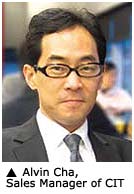 CIT specializes in DVRs, enjoying 20 percent revenue growth in a slow 2009. Its solutions are mainly exported to North America and Europe, representing about 70 percent of sales, said Alvin Cha, Sales Manager. CIT specializes in DVRs, enjoying 20 percent revenue growth in a slow 2009. Its solutions are mainly exported to North America and Europe, representing about 70 percent of sales, said Alvin Cha, Sales Manager.
“We expected 10 percent growth this year, with the help of our new high-end H.264 standalone DVR series released at end of 2009,” Cha said.
Strategy and Core Competence
CIT focuses on customer needs with targeted solutions. “We develop and provide unique applications that help our customers in specific market areas, such as PoS or ATMs,” Cha said. It offers a DVR with PoS and ATM integration for specific users.
The company has extensive know-how in managing video codecs and application software, making its offerings competitive. It also understands networking, which will be applied for its NVRs and network cameras, Cha said.
CIT conducts business by building exclusive partnerships in each country. This practice protects both the market and its customers, Cha said.
Future Outlook
IP will be the next focus for CIT. “We will develop an NVR,” Cha said. “Our goal is to have more intelligent functions.”
|
|
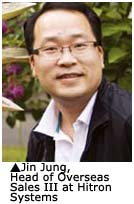 The economic downturn affected Asian makers like Hitron Systems. “Last year's sales figures were little short of disastrous,” said Jin Jung, Head of Overseas Sales III. Its sales for 2009 dropped, due to weak market conditions and fewer new construction projects. Its business for 2010 is expected to return to 2008 levels, thanks to strong demand. The economic downturn affected Asian makers like Hitron Systems. “Last year's sales figures were little short of disastrous,” said Jin Jung, Head of Overseas Sales III. Its sales for 2009 dropped, due to weak market conditions and fewer new construction projects. Its business for 2010 is expected to return to 2008 levels, thanks to strong demand.
Strategy and Core Competence
The company's solid product development helped it recover from the recession. “Our core competence is our optimized and customized video solutions, offering our customers more choice in products,” Jung said. “Along this line, the company has invested more than 5 percent of sales in engineering and R&D investments every year.”
Hitron has an extensive video lineup. Its speed domes include video analytics and software integration with DVRs. Other edge devices have high resolution of 650 TVLs, as well as day-night abilities with DNR and WDR, including smart analytic functions.
In displays, Hitron's LCD monitor can go up to 700 TVLs, suited for viewing high-resolution footage. The company is also committed to network solutions and interoperability. It joined ONVIF and offers compliant products, increasing its functionality.
Future Outlook
As the video surveillance market matures, Hitron faces more competition. It plans to adapt its accumulated experience of 25 years in analog products toward developing integrated and intelligent solutions, such as video analytics. “Hitron has also expected network security market's growth and has been preparing in advance,” Jun said.
Hitron recognized the importance of ONVIF, as network video uptake is set to surpass analog surveillance within the next three to four years. “Now we are pouring our energy and effort into here,” Jung said.
|
|
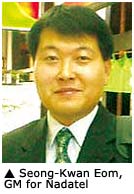 Nadatel specializes in video compression and transmission. The company was founded in 1992 and developed personal video conferencing. Its networking expertise is now applied toward security, with offerings in DVR and network products. Nadatel specializes in video compression and transmission. The company was founded in 1992 and developed personal video conferencing. Its networking expertise is now applied toward security, with offerings in DVR and network products.
Strategy and Core Competence
Nadatel prides itself on advanced technology, reliable quality and competitive price. The company provides total customization to meet customer needs, regardless of the market or country. In its 18 years of operation, Nadatel has provided more than 20,000 IP products and 300,000 stand-alone DVRs, said Seong-Kwan Eom, GM.
Nadatel adapted to market trends by updating its hardware platform and operating system this year. This change helped shorten development time and extended product ranges, Eom said.
As the recession has affected customer purchasing behavior, Nadatel extended its low-cost and middle-range product lineup to reflect demand, Eom said. This enabled revenue to hold steady. It also switched from DSPs to SoCs to reduce costs but offer the same functionality to customers.
Future Outlook
Nadatel plans to expand its offerings in high resolution and network solutions. It launched an HD stand-alone DVR, Eom said. The company's product development will continue to be innovative and cost-effective, providing reliable products and ultimately customer satisfaction.
|
|
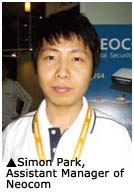 Neocom was founded in 1999, enjoying 12-percent growth in 2009. It expects 2010 to be an even better year, with sales set to reach 20 percent, said Simon Park, Assistant Manager. The company specializes in network cameras, sold to users in retail, government and military applications, Park said. Neocom was founded in 1999, enjoying 12-percent growth in 2009. It expects 2010 to be an even better year, with sales set to reach 20 percent, said Simon Park, Assistant Manager. The company specializes in network cameras, sold to users in retail, government and military applications, Park said.
Strategy and Core Competence
Demand for Neocom's solutions is strong in Korea, with the domestic market representing 70 percent of sales. The other 30 percent of sales goes overseas, including OEM and own-brand solutions, Park said.
Its recent product launches include a dual-CCD true day/night camera, which it developed on its own. Another offering is its triple camera, combining three cameras with IR illumination in one. It enables simultaneous wide-area and close-up monitoring, viewed on multiple screen in a single monitor, to capture all details, Park said.
Neocom is focused on transportation, launching a four-channel mobile DVR.
Future Outlook
Neocom plans to produce budget-friendly offerings that are reliable. “For this year, we will try to make good priced products and also try to have less than 1 percent of our cameras defective,” Park said. The company offers both high-end and entry-level products, so users with tight budgets can find models that are affordable and well-made.
Neocom plans to expand internationally by entering North and South America, Park said.
|
|
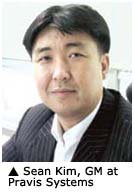 Pravis Systems emphasizes putting its customers first. “One core competence that makes Pravis outstanding is listening carefully to what our customer say and request,” said Sean Kim, GM. The company keeps track of customer needs through a database, which are applied to product development as soon as possible. Pravis Systems emphasizes putting its customers first. “One core competence that makes Pravis outstanding is listening carefully to what our customer say and request,” said Sean Kim, GM. The company keeps track of customer needs through a database, which are applied to product development as soon as possible.
This customization is applied to its OEM and branded business. “By mixing both strategies, it allows Pravis to grasp more business opportunities in each country,” Kim said.
Strategy and Core Competence
Pravis is responsive to customer needs by rolling out products suited for different price points. While its budget offerings are affordable, its first priority is system reliability, Kim said. It also features unique design for the GUI and features.
The company's current product lineup emphasizes IP and new solutions. It will release embedded NVRs and HD cameras in the third quarter of 2010.
Future Outlook
Pravis' product development will be in line with component breakthroughs, as the SoC determines most of the features and functions in a system. “Accordingly, it is a very important question how manufacturers will add more value to make themselves different,” Park said.
The company also plans to expand its line of HD DVRs, HD cameras and embedded NVRs.
|
|
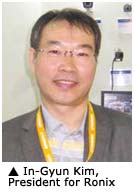 Founded in 1999, Ronix launched its export business immediately. Currently, 90 percent of its sales were generated overseas, dominated by Germany, the U.S. and Japan. Founded in 1999, Ronix launched its export business immediately. Currently, 90 percent of its sales were generated overseas, dominated by Germany, the U.S. and Japan.
Due to the global economic crisis, growth slowed for Ronix in 2009. This year, with a more comprehensive product line, the company expects growth of more than 50 percent, said In-Gyun Kim, President. The majority of sales were generated from its branded products, with the remaining portion generated from OEM sales.
Strategy and Core Competence
Ronix specializes in ultra low-lux day/night cameras, with unique super D/N technology since 2001. With a strong focus in technology development, 30 percent of the company's staff work in R&D, Kim said. Its R&D spending makes up 15 percent of the company's annual budget.
Another development emphasis is weatherproof cameras. The cameras are IP68-rated and include WDR, 3-DNR and day/night technology.
In 2009, Ronix planned to expand market share worldwide. It is adopting the HDMI standard for its new products, which include an HD converter and analog viewer for full HD output, Kim said.
Future Outlook
Ronix is working on network cameras with SD resolution that can be restored to full HD, Kim said. It will launch 2-megapixel cameras that feature its in-house hardware and software.
|
|
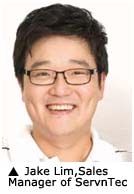 ServnTec was able to beat the market in 2009, with 15 percent revenue growth. It expects sales to grow another 10 percent for the coming year, thanks to increased demand, said Jake Lim, Sales Manager. Its main markets were the U.S., Europe and Korea. ServnTec was able to beat the market in 2009, with 15 percent revenue growth. It expects sales to grow another 10 percent for the coming year, thanks to increased demand, said Jake Lim, Sales Manager. Its main markets were the U.S., Europe and Korea.
This growth coincided with the launch of its branded business, which had been exclusively OEM-based until 2008. It stays competitive with its R&D know-how. “We always consider three years into the future for technology, based on the marketing environment and surveys of customer opinion from around the world,” Lim said.
Strategy and Core Competence
ServnTec was an early adopter of hybrid solutions, such as its hybrid PC DVR. Its HD-CCTV solution can interface with analog, network and HD cameras on one platform. “We already have a higher preference for these products compared to our competitors in the world,” Lim said. “We were prepared four years ago and we get the highest, most stable solutions with competitive pricing.”
Future Outlook
ServnTec will go forward by consulting its distributors worldwide for their opinions, along with understanding market trends for each country. This ensures the company has the most updated information for its future road map. “The surveillance industry is based on preserving human life and safety,” Lim said. This reflects the company's purpose, which is emphasized for upcoming product developments.
|
|
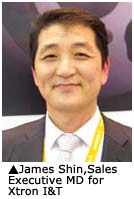 Xtron, founded in 2003, sees a good future for HDcctv as well as the growing need for IP surveillance. Its export business generated about 90 percent of its sales revenue. Roughly 20 percent of sales were generated from branding and the other 80 percent was from OEM sales. Europe, the Middle East and the U.S. are its major overseas markets. Xtron, founded in 2003, sees a good future for HDcctv as well as the growing need for IP surveillance. Its export business generated about 90 percent of its sales revenue. Roughly 20 percent of sales were generated from branding and the other 80 percent was from OEM sales. Europe, the Middle East and the U.S. are its major overseas markets.
In 2009, sales were affected by the global economic downturn, said James Shin, Sales Executive MD. However, the company expects more than 30 percent growth this year, due to the market rebound.
Strategy and Core Competence
With an emphasis in HD analog cameras, Xtron develops its own camera boards, firmware and performs image tuning in-house. Its HD product lines are widely used for medical applications, residential and building security.
The company understands how to integrate CMOS technology for megapixel cameras. “While focusing on analog cameras for the moment, we will continue to develop a comprehensive product line, such as network cameras and underwater cameras,” Shin said. “We offer 5-megapixel cameras in Germany.”
Future Outlook
In the future Xtron will focus more on promoting its own brand, especially in India, the Philippines, Singapore, Malaysia and Thailand. “Branding allows us to be able to control our price and maintain our product quality,” Shin said.
Despite fierce price wars, Xtron will uphold high production standards. “Ensuring quality helps maintain long-term relationships with customers,” Shin said.
|